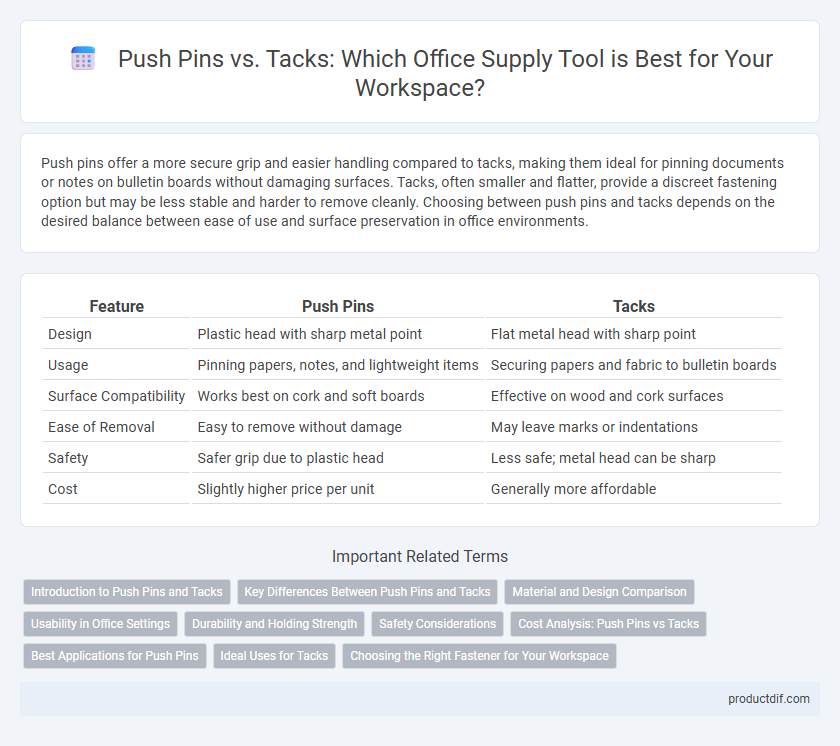Push pins offer a more secure grip and easier handling compared to tacks, making them ideal for pinning documents or notes on bulletin boards without damaging surfaces. Tacks, often smaller and flatter, provide a discreet fastening option but may be less stable and harder to remove cleanly. Choosing between push pins and tacks depends on the desired balance between ease of use and surface preservation in office environments.
Table of Comparison
| Feature | Push Pins | Tacks |
|---|---|---|
| Design | Plastic head with sharp metal point | Flat metal head with sharp point |
| Usage | Pinning papers, notes, and lightweight items | Securing papers and fabric to bulletin boards |
| Surface Compatibility | Works best on cork and soft boards | Effective on wood and cork surfaces |
| Ease of Removal | Easy to remove without damage | May leave marks or indentations |
| Safety | Safer grip due to plastic head | Less safe; metal head can be sharp |
| Cost | Slightly higher price per unit | Generally more affordable |
Introduction to Push Pins and Tacks
Push pins feature a plastic or metal head with a sharp metal point, designed for easily securing papers or notes to corkboards and soft surfaces. Tacks, often made entirely of metal with a flat, wide head, are ideal for fastening materials to wood or other harder substrates where durability and a flush finish are needed. Both push pins and tacks serve essential roles in office organization and display, with push pins offering quick repositioning and tacks providing a more permanent hold.
Key Differences Between Push Pins and Tacks
Push pins feature a plastic or metal head with a sharp, pointed metal pin designed for easy insertion and removal from bulletin boards and walls. Tacks have a flat or slightly rounded metal head with a short, sharp spike ideal for securing papers or lightweight materials to wood or cork surfaces. Push pins provide better grip and visibility, while tacks offer a low-profile hold suited for more discreet fastening.
Material and Design Comparison
Push pins are typically made from durable plastic heads with sharp metal points, providing easy gripping and removal, while tacks often feature flat metal heads and shorter, sturdier pins designed for a flush hold on surfaces. The ergonomic design of push pins allows for quick application and removal without damaging materials, whereas tacks offer a minimalist profile ideal for permanent or semi-permanent fixtures on bulletin boards and wood surfaces. Material composition impacts their durability and suitability: plastic push pins resist rust and are lightweight, whereas metal tacks provide greater strength and longevity but may cause more surface indentation.
Usability in Office Settings
Push pins offer superior usability in office settings due to their ease of handling and ability to securely fasten documents without damaging surfaces. Tacks, while effective for heavier materials, can be more difficult to use and may leave larger holes on bulletin boards or walls. Push pins enhance efficiency by providing quick, reusable attachment options ideal for frequently updated displays and notices.
Durability and Holding Strength
Push pins typically offer higher durability and holding strength compared to traditional tacks due to their reinforced plastic heads and sharper, sturdier metal points. Tacks may be prone to bending and losing grip over time, especially on thicker materials, whereas push pins maintain secure positioning on bulletin boards and thicker surfaces. Selecting push pins ensures longer-lasting hold and reduced risk of damage to pinned items or surfaces.
Safety Considerations
Push pins feature a plastic or metal head that reduces the risk of accidental injury compared to traditional tacks, which have exposed sharp metal heads. Tacks pose a higher safety hazard in environments with children or pets due to their pointed ends and smaller gripping surface. Selecting push pins enhances office safety by minimizing puncture wounds and improving ease of use during board or wall mounting tasks.
Cost Analysis: Push Pins vs Tacks
Push pins generally cost more than tacks due to their plastic or metal heads and ergonomic design, averaging around $5 to $10 per 100 pieces compared to tacks at $3 to $6 per 100 pieces. The higher price of push pins is offset by their enhanced grip and reusability, reducing the need for frequent replacements. Businesses should evaluate the balance between upfront cost and long-term usability when choosing between push pins and tacks for office supply purchases.
Best Applications for Push Pins
Push pins are ideal for securing lightweight papers, posters, or fabric onto corkboards, providing easy repositioning without damaging surfaces. Their plastic heads offer a comfortable grip, making them suitable for frequent adjustments in classrooms, offices, or craft projects. Unlike tacks, push pins can be used on softer materials, minimizing puncture damage and maintaining material integrity.
Ideal Uses for Tacks
Tacks are ideal for securing papers or lightweight materials to corkboards or wooden surfaces without causing significant damage. Their flat, broad heads provide stability, making them perfect for bulletin boards, crafts, or upholstery projects. Tacks work best in settings where a low-profile fastening is needed, such as offices or classrooms.
Choosing the Right Fastener for Your Workspace
Push pins provide a secure hold on bulletin boards and cork surfaces with their easy-to-grip plastic heads, making them ideal for frequently updated displays. Tacks, often made of metal with flat heads, offer a more discrete fastening option for paper or fabric but may be harder to remove without damaging the surface. Select push pins for versatility and ease of use, or opt for tacks when a low-profile fastener is needed in your workspace.
Push pins vs Tacks Infographic

 productdif.com
productdif.com